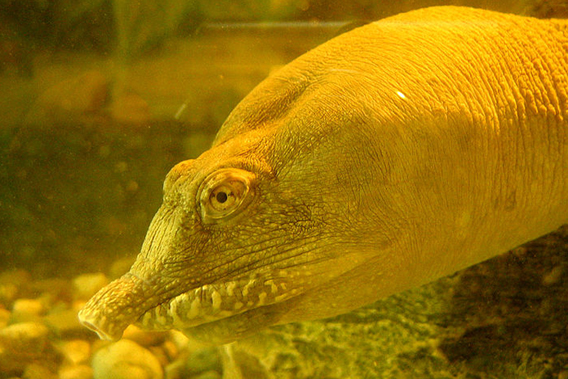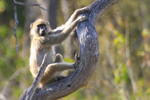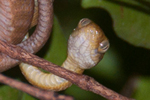
Chinese soft-shelled turtle in captivity. Photo by: Bastet78.
One of China’s most commonly farmed turtles for consumption, the Chinese soft-shelled turtle (Pelodiscus sinensis), has a unique ability: it urinates out of its mouth. Researchers in Singapore, writing in The Journal of Experimental Biology, have discovered that the Chinese soft-shelled turtle excretes most of its urine from its mouth instead of its kidneys. They hypothesize that the turtle developed this ability in order to survive in brackish waters, which contain considerably more salt than freshwater.
The scientists became curious about the turtle’s waste habitats, when they noticed that the air-breathing animals would submerge their heads underwater for long periods, between 20-100 minutes. Measuring the water for urea, a primary compound in urine, the researchers found 50 times more urea in the water than was produced by the animal’s cloaca, or waste cavity.
“The ability to excrete urea through the mouth instead of the kidney might have facilitated the ability of [the Chinese soft-shelled turtle] and other soft-shelled turtles to successfully invade the brackish and/or marine environment,” the scientists write. If the turtle passed its urine through its kidneys it would need to make up the lost fluid by drinking water, but, although surrounded by water, the Chinese soft-shelled cannot drink salty water because it would eventually result in toxicity; reptiles are especially poor at ridding themselves of salt. By urinating through the mouth, the Chinese soft-shell turtle has evolved not to need large amounts of water.
The scientists believe that the Chinese soft-shelled turtle uses gill-like projections on the inside of its mouth to expel the urine, much like fish urinate out of their gills.
Although the Chinese soft-shelled turtle numbers in the millions in captive farms, the species is vanishing from the wild. Currently the IUCN Red List categorizes the species as Vulnerable.
CITATION: Ip, Y. K., Loong, A. M., Lee, S. M. L., Ong, J. L. Y., Wong, W.P. and Chew, S. F. (2012). The Chinese soft-shelled turtle, Pelodiscus sinensis, excretes urea mainly through the mouth instead of the kidney. J. Exp. Biol. 215, 3723-3733.
Related articles
Brainless slime mold uses slimy memory to navigate
(10/08/2012) How do you navigate space efficiently without a brain? Slime, according to a surprising new study in the Proceedings of the National Academy of Sciences (PNAS) of a brainless slime mold named Physarum polycephalum. Scientists at the University of Sydney have discovered that the mold secretes slime as an ‘external spatial memory’ to make sure it doesn’t end up going around in circles.
Photos: new mammal menagerie uncovered in remote Peruvian cloud forest

(10/03/2012) Every year scientists describe around 18,000 new species, but mammals make up less than half a percent of those. Yet mammal surprises remain: deep in the remote Peruvian Andes, scientists have made an incredible discovery: a rich cloud forest and alpine grassland ecosystem that may be home to no less than eight new mammal species. Although most of these new mammals are currently under study—and have not been officially described yet (a process which can take several years)—lead scientists, Horacio Zeballos of Peru and Gerardo Ceballos of Mexico are certain they have uncovered a small forest, surrounded by deforestation and farmland, that shelters a remarkable menagerie of mammals unknown to scientists until now.
Mr. Darcy and the Manic Pixie Dream Girl: monkeys display distinct personality types

(10/01/2012) Remember the ‘man with no name’ played by Clint Eastwood in A Fistful of Dollars, Mr. Darcy in Jane Austen’s Pride and Prejudice, or the bubbly cute girl in every romantic comedy from Legally Blonde to Breakfast at Tiffany’s? Each of these characters represent an over-the-top type of human personality—loner (man with no name), aloof (Darcy), and nice (the bubbly cute girl)—but a new study in the Proceedings of the National Academy of Sciences (PNAS) finds that it’s not only humans that show such distinct types, but baboons as well. Studying 45 female chacma baboons in Botswana’s Moremi Game Reserve over seven years, the researchers found that such personality types, unrelated to social statues, helped to determine the animals’ overall sociability and the stability of their relationships.
Arachnopocalypse: with birds away, the spiders play in Guam

(09/17/2012) The island of Guam is drowning in spiders. New research in the open-access journal PLOS ONE has found that in the wet season, Guam’s arachnid population booms to around 40 times higher than adjacent islands. Scientists say this is because Guam, a U.S. territory in the Pacific, has lost its insect-eating forest birds. Guam’s forests were once rich in birdlife until the invasion of non-native brown tree snake (Boiga irregularis) in the 1940s decimated biodiverse bird communities. Now, the island is not only overrun with snakes, but spiders too.
Sacrificial squid has unique way of deterring predators
(09/04/2012) Octopoteuthis deletron—this deep-dwelling, unassuming little squid may appear plain and boring, but when threatened, it has a peculiar way of defending itself. This foot-long invertebrate behaves a bit differently than most of its close cousins: it drops its arms.
Unidentified poodle moth takes Internet by storm

(08/29/2012) A white moth from Venezuela that bears a striking resemblance to a poodle has become an Internet sensation, after cryptozoologist Karl Shuker posted about the bizarre-looking species on his blog. Photographed in 2009 in Venezulea’s Canaima National Park in the Gran Sabana region by zoologist Arthur Anker from Kyrgyzstan, the white, cuddly-looking moth with massive black eyes has yet to be identified and could be a species still unknown to science.